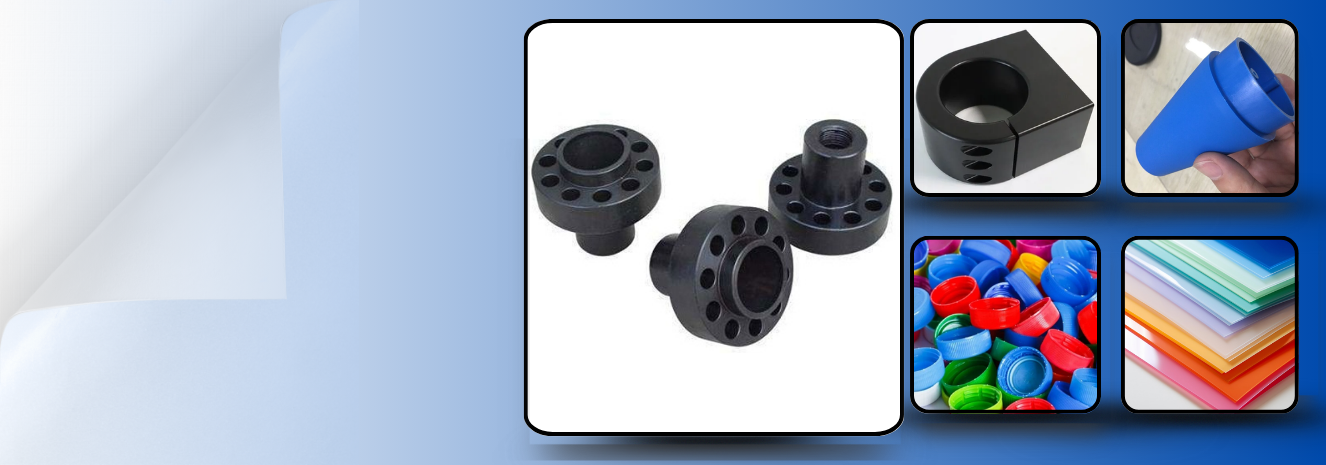Wide Range of Our Plastic Materials
Below is a summary of the main materials we use in our molding processes, highlighting their features and common applications.
HDPE Molding
High-Density Polyethylene (HDPE) is both lightweight and strong, providing outstanding resistance to impacts, moisture, and chemicals. It is commonly utilized in packaging materials, plumbing pipes, casings for consumer electronics, and products resistant to corrosion.
Polypropylene (PP)
Polypropylene (PP) is a thermoplastic polymer known for its outstanding resistance to chemicals and abrasion, as well as its durability with repeated use. It is ideal for applications in packaging, automotive battery cases, electrical housings, and home appliances.
Acrylonitrile Butadiene Styrene (ABS)
ABS is recognized for its strength, durability, dimensional consistency, and ease of manufacturing. Its shiny finish and ability to resist impacts make it a popular consumer electronics casing, car interior components, home appliance covers, and protective packaging.
Polystyrene (PS)
Polystyrene (PS) is a lightweight, clear, and durable material that makes it ideal for use in disposable and lightweight parts. It is well-suited for packaging, everyday disposable items, insulation, and protective components across different industries.
Polyoxymethylene (POM)
Polyoxymethylene (POM) is a type of plastic recognized for its impressive rigidity, sleek finish, and low friction characteristics. It is frequently used in precise parts for cars, electrical connectors, household devices, plumbing valves, and industrial machines where exact measurements are crucial.
Polyethylene (PE)
Polyethylene (PE) is the most commonly used plastic worldwide, available in variations like High-Density Polyethylene (HDPE) and Low-Density Polyethylene (LDPE). It has great flexibility and resistance to moisture, making it suitable for use in automotive parts such as gears and bearings, electrical connectors, parts of home appliances, elements of industrial equipment, and plumbing components.
Nylon (PA)
Nylon, also known as polyamide, is a durable, wear-resistant material that remains resilient under high mechanical stress. It is commonly used in automotive components such as gears and bearings, electronics, industrial machine components, and plumbing fittings.
Polymethyl Methacrylate (PMMA)
Polymethyl Methacrylate (PMMA), commonly known as Acrylic, is transparent and resistant to ultraviolet light, making it an excellent choice for applications requiring superior optical qualities, such as car light covers and display panels, protective covers for industrial machinery, and high-quality packaging across the automotive and electronics fields.
Low-Density Polyethylene (LDPE)
Low-Density Polyethylene (LDPE) is recognized for its flexibility and resistance to moisture and impacts. These characteristics make it a favored material for producing various items, including squeeze bottles, caps, liners, packaging, protective wraps and sheets, as well as flexible wire coatings.
Polycarbonate (PC)
Polycarbonate (PC) is a durable, transparent, and highly impact-resistant material, which makes it perfect for safe and strong components across different industries. It is commonly used in the creation of clear covers, consumer electronics housings, car headlight lenses, and electrical switch components.
Thermoplastic Elastomer (TPE)
Thermoplastic elastomers, or TPE, combine the simple features of plastics with the flexibility of rubber. This blend makes TPE a great choice for creating soft comfortable grips for consumer electronics, the seals and gaskets for the automotive sector, industrial hoses, and flexible connectors for electrical systems.
Thermoplastic Rubber (TPR)
TPR provides a unique blend of a soft, rubber-like feel and the capability to be shaped like plastic, making it perfect for crafting flexible and sturdy parts. It is often used in various fields, including automotive weatherstrips, overmolded grips, vibration dampeners, industrial seals, and handles for home appliances.
